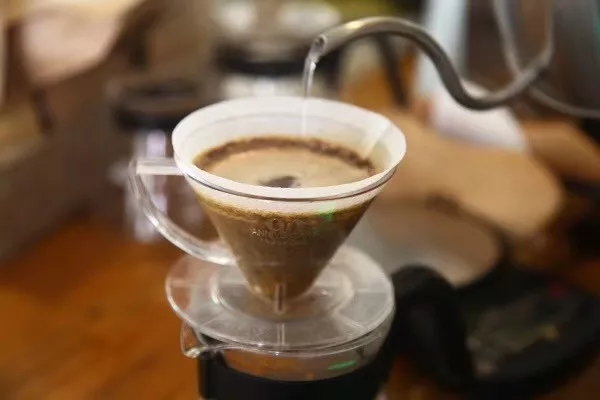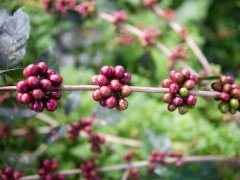What is Blue Mountain Coffee? Do you know the story of Blue Mountain Coffee? The cooking parameters are suggested.

Professional coffee knowledge exchange more coffee bean information please follow the coffee workshop (Wechat official account cafe_style)
Jamaica, the origin of Blue Mountain Coffee, gets its name from the Blue Mountains surrounded by the Caribbean Sea.
Jamaican Blue Mountain Coffee has always been a divine existence in China, and almost every coffee shop must claim to have it. It's just that not many people really use blue mountain beans. According to Jamaica Coffee Bureau export statistics as of 2004, 85% of the limited Blue Mountain coffee bean quotas were exported to Japan, 5% to the United States, 5% to Europe and 5% to other countries. However, China accounts for 15% of the global consumption and distribution of authentic Jamaican Blue Mountain coffee, according to the International Coffee Association. This is due to the fact that some shares of Jamaican Blue Mountain coffee in Japan, Australia and Europe are exported to Taiwan through direct subsidiaries.
Planting conditions:
The legal cultivation area of Jamaican Blue Mountain Coffee is on the eastern side of the island of Jamaica, with a total altitude of 7402 feet. Only at an altitude of 3000mur5000 feet can a balanced and slightly acidic Jamaican Blue Mountain Coffee be grown. Only in this altitude Blue Mountain area, the Jamaican Blue Mountain Coffee is considered to be 100% Jamaica Blue Mountain Coffee. The coffee grown below 3000 feet above sea level is alpine coffee, which is licensed to use High Mountain Coffee. The total amount of alpine coffee grown is five times that of Jamaican Blue Mountain coffee, and most private estates grow alpine coffee for export and domestic sale as a tourism specialty. As for the blue mountain area above 5000 feet above sea level, the jungle is dense and is not suitable for any crop.
History of Blue Mountain Coffee:
In 1717 King Louis XV of France ordered the cultivation of coffee in Jamaica, and in the mid-1920s, Nicholas, Governor of Jamaica. NicholasLawes imported Arabica seeds from Martinique and began to plant them in St. Andrews (St.Andrew). To this day, St. Andrews is still one of the three major producers of Jamaican Blue Mountain Coffee, with the other two producing areas: Portland (Portland) and St. Thomas (St.Thomas).
In eight years, Jamaica exported more than 375 tons of pure coffee.
In 1932, coffee production reached its peak and more than 15000 tons of coffee was harvested.
In 1950, the Government of Jamaica established the Jamaica Coffee Industry Committee (theJamaicaCoffeeIndustryBoard), which sets quality standards for Jamaican coffee and oversees the implementation of quality standards to ensure the quality of Jamaican coffee. The Commission awarded special official seals to raw and roasted coffee exported from Jamaica, which is the highest-level national coffee institution in the world. At present, there are six kinds of marks that can represent the origin of Blue Mountain Coffee, such as Mafis River Embankment Central Factory (MBCE), Blue Mountain Coffee Cooperative Factory (MHCCT), Portland Blue Mountain Coffee Cooperative Factory (PXXSH), Coffee Industry Association (Warren Ford), Coffee Industry Association (St. John's Peak) and Lanli (JAS).
By 1969, the situation had improved because the use of Japanese loans had improved the quality of production, thus ensuring the market. By now, this kind of coffee has reached the point of being feverishly loved.
By 1981, about 1500 hectares of land in Jamaica had been reclaimed to grow coffee, followed by investment in another 6000 hectares of coffee land. In fact, today's Blue Mountain area is a small area with a planting area of only 6000 hectares, and it is impossible to grow all the coffee marked "Blue Mountain" there.
Another 12000 hectares are used to grow two other types of coffee: Alpine Top Coffee and Jamaican Coffee.
The sour, sweet and bitter taste of Blue Mountain Coffee are perfectly matched together and have excellent flavor and aroma, so it is suitable for making individual coffee.
Cooking suggestions:
It is recommended that the water temperature is 88 ℃, the degree of grinding is small Fuji 4, the ratio of water to powder is 1:12, and the total time is about 1:40.
Important Notice :
前街咖啡 FrontStreet Coffee has moved to new addredd:
FrontStreet Coffee Address: 315,Donghua East Road,GuangZhou
Tel:020 38364473
- Prev

aged mantinine| Why is it called aged mantning front street brewing advice
Professional coffee knowledge exchange More coffee bean information Please pay attention to coffee workshop (Weixin Official Accounts cafe_style) Indonesia is the world's largest archipelago country. Arabica coffee was introduced during the Dutch colonial period in the 18th century and began to be planted until modern times. It has become one of the top five coffee producers in the world in terms of output. Its main producing areas are located on Sumatra, Java and Sulawesi islands. Sumen
- Next

Taste and flavor characteristics of Kenyan coffee beans recommended parameters for cooking Kenyan AA coffee beans with V60 filter cup
Professional coffee knowledge exchange more coffee bean information Please pay attention to Coffee Workshop (Wechat official account cafe_style) Africa has always been one of the best coffee producers in the world, and is famous for its charming sour and aroma, and Kenya is certainly not absent. Kenya (Kenya) is located in eastern Africa, adjacent to Ethiopia, the "source of coffee". Although the soil is fertile, it should be
Related
- Detailed explanation of Jadeite planting Land in Panamanian Jadeite Manor introduction to the grading system of Jadeite competitive bidding, Red bid, Green bid and Rose Summer
- Story of Coffee planting in Brenka region of Costa Rica Stonehenge Manor anaerobic heavy honey treatment of flavor mouth
- What's on the barrel of Blue Mountain Coffee beans?
- Can American coffee also pull flowers? How to use hot American style to pull out a good-looking pattern?
- Can you make a cold extract with coffee beans? What is the right proportion for cold-extracted coffee formula?
- Indonesian PWN Gold Mandrine Coffee Origin Features Flavor How to Chong? Mandolin coffee is American.
- A brief introduction to the flavor characteristics of Brazilian yellow bourbon coffee beans
- What is the effect of different water quality on the flavor of cold-extracted coffee? What kind of water is best for brewing coffee?
- Why do you think of Rose Summer whenever you mention Panamanian coffee?
- Introduction to the characteristics of authentic blue mountain coffee bean producing areas? What is the CIB Coffee Authority in Jamaica?

